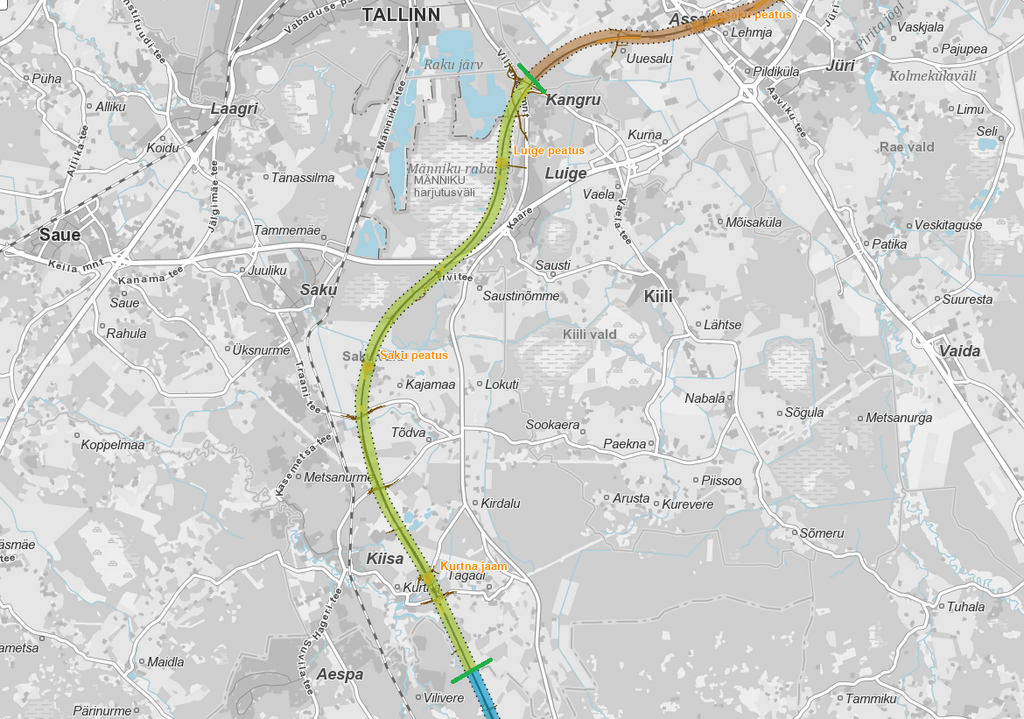On 22 March, the Estonian Consumer Protection and Technical Regulatory Authority (TTJA) declared the environmental impact assessment (EIA) report of the 19-kilometer section “Kangru – Harju and Rapla county border” to be compliant, which brings closer the start of the construction of the section.
The Estonian branch of RB Rail AS requested the initiation of the impact assessment on its own initiative at the beginning of 2019. A little more than three years later, the EIA has been completed. The track section in question runs in the territory of the rural municipalities of Kiili and Saku up to the county border, crossing Viljandi Road. The route runs on the eastern edge of the Manniku bog, crosses the Tallinn Ring Road and continues in a cultural landscape between the Tallinn-Rapla-Turi road and the Tallinn-Viljandi railway line.
Kärt Mae, Environmental and Sustainability Lead at Rail Baltic Estonia emphasizes that given the complexity of the project, various measures to mitigate its environmental impact must be introduced. “The extensive and complex nature of this project makes it crucial to address its potential impacts. According to the EIA report, measures will be implemented to avoid, mitigate, or compensate for any adverse effects associated with the project,” said Mae.
“For instance, the route section intersects with the green network corridor at four points, the most significant of which is the green area surrounding Tallinn, where there is heavy traffic and highways. Additionally, the Männiku, Raku, and Tammemäe quarry lakes reside in this area, and the railway line cuts across the Vääna river at two points. This river is an important watercourse in the region, particularly for animal movement routes,” added the environmental expert.

Railway can have a barrier effect on animal habitats, therefore, mitigating measures both during the construction and the operational phase must be implemented. To address this concern, five sizable animal crossings are envisaged in this section. These include three ecoducts, a substantial passageway by the Kurna stream, and a bridge spanning the Vääna river. Additionally, several passages will be created for small animals, such as mammals and amphibians.
Furthermore, to assess the necessity of noise mitigation measures, noise maps were created based on assessments that analyzed the comparison between national requirements and the predicted noise levels. Where the assessments indicated that noise levels may exceed acceptable limits, appropriately sized noise barriers will be designed and planned for implementation.
As per the requirements of TTJA, the EIA report is mandatory and provides sufficient information for the issuance of a building permit. The construction procedures must comply with the main project’s solution, which incorporates environmental measures in line with the EIA or any other measures that provide the same level of effectiveness. To ensure that these measures are entirely implemented and effective, monitoring will be performed throughout the construction process, as well as during the operational phase.
To effectively manage environmental concerns, Rail Baltica delivery organizations develop a comprehensive environmental management plan for each assessed section. This plan encompasses both mandatory measures required in the permit issuance process, as well as voluntary measures decided upon by the project implementers. The plan is regularly reviewed and updated to reflect any new information or changes in circumstances, with additional or refined measures added as needed.
The tender for the construction of the railway section is planned to be announced in the second half of this year.
Rail Baltica environmental impact assessment is carried out in parallel with the ongoing design of the mainline. The important impact areas that are evaluated during the EIA are wildlife, noise and vibrations, animal migration, protection of fauna and flora species and their natural habitats, barrier effect mitigation, preserving natural conditions, landscaping, and infrastructure resilience to the climate change. The first EIA report of Rail Baltica’s Ülemiste-Kangru section was deemed as meeting the requirements in July 2022, and the second, for the section from the Harju-Rapla County border to Hagud, in September 2022. A total of eight reports will be prepared for the entire 213-kilometer Rail Baltica line in Estonia.
